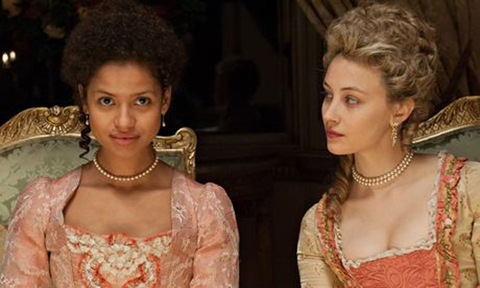
By Barbara Smith
Contributing Writer
The name Belle means “beautiful,” and the movie “Belle,” which opens in San Diego this weekend, is a beautifully filmed production but one that brings to light an ugly practice in history, that of slavery. The movie, a British drama set in late 1700’s England, takes its name from Dido Elizabeth Belle, who was the illegitimate mixed race daughter of a Royal Navy officer and a West Indies slave. Left by her father to be raised by his uncle, Lord Mansfield (Tom Wilkinson) and his wife (Emily Watson), at his Kenwood House estate, she is cared for and loved by the Mansfields who raise her as an aristocrat alongside her cousin Lady Elizabeth Murray. But in accordance with the conventions of that time, she is not afforded the same rights as her cousin, shepherded away from family gatherings, only to be seen after formal events of the day are over. She is “too high for servants, too low for dinner guests,” she is told, because of her bi-racial heritage.
As children, Dido (Gugu Mbatha-Raw) and Elizabeth (Sarah Gadon) are the best of friends and it is only when they become older that they become aware of the inevitable inequities living in a society that condones slavery. When Dido and Elizabeth become of marriageable age, class and race come into play in their suitors. Courted by the handsome and socially well-placed Oliver Ashford (James Norton), Dido is scorned by his brutish brother (Tom Felton) and condescending mother (Miranda Richardson). Her attraction to an ambitious young lawyer, John Davinier (Sam Reid), is discouraged by her uncle, because of his lower station in life, but it is through Davinier’s efforts that Lord Mansfield, as lord chief justice, makes a court decision that eventually leads to the end of slavery in England.
The story was inspired by the 1779 painting of Dido beside her cousin Elizabeth, now hanging in Scotland’s Scone Palace. The portrait was one of the first to show a bi-racial subject on an equal level with a white aristocrat. Little is known of the actual facts of Dido Elizabeth Belle’s life, and screenwriter Misan Sagay (“Their Eyes Were Watching God”) along with director Amma Asante (“A Way of Life”) have created an engaging story line fused with actual historical events so that even though we are watching an elegant period drama—and a sumptuously filmed one at that—we are still very much connected with contemporary issues. The infamous legal case of the Zong slave ship massacre, which is woven into the plot, in which approximately 142 enslaved Africans were drowned and whose traders attempted to collect insurance money on their “human cargo,” became an important victory for abolitionists. And despite the romantic story line that contributes to the movie’s appeal, one can’t help but make uncomfortable connections to recent developments where accusations of racism have dominated headlines. Belle’s role in providing key evidence that influences Lord Mansfield’s judicial decision, implausible though it is in a historical context, still makes for a tidy and happy resolution to the story, unlike the ugly continuing saga of the Sterling/Clippers debacle.
The film, which, cinematically, is a feast for the eyes with its lavish costumes, green rolling landscapes and ornate décor of the 18th century aristocracy, employs its characters to propel a fairly predictable but still intriguing plot. Gugu Mbatha-Raw, whose British training includes theatre, film and television, plays the character of Dido with grace and passion. Born in England of an English mother and South African father, she, like the character she portrays, is bi-racial, and, while she has shared in interviews that she did not experience the same kind of discrimination as Dido, she brings a fierce intensity to the role. Tom Wilkinson’s Lord Mansfield is a powerful presence in the movie; he is a man of conviction and compassion who must balance the contradictions inherent in upholding a law which he sees as barbaric. His is a finely nuanced portrayal.
As we follow Belle’s journey to find her place in society, we cannot help but ask the important question of how each of us is defined. Is it by skin color? By family lineage? Or by the content of our character? “Belle” in its beauty transports you to another time and place, and amid the finery and gorgeous Georgian backdrop, brings to light an era in history that is still all too present.


